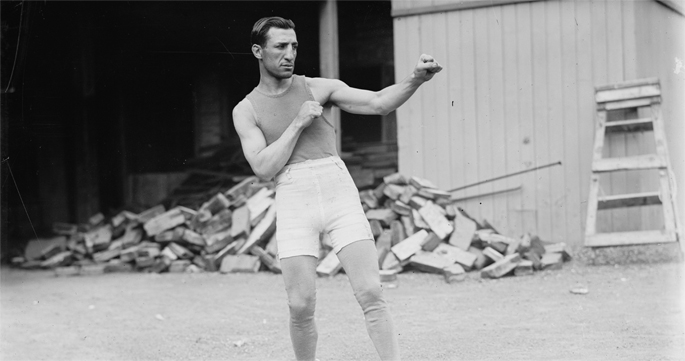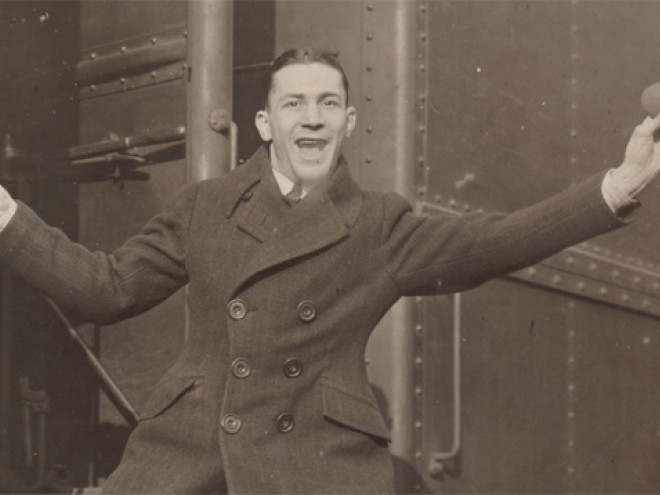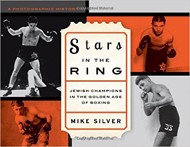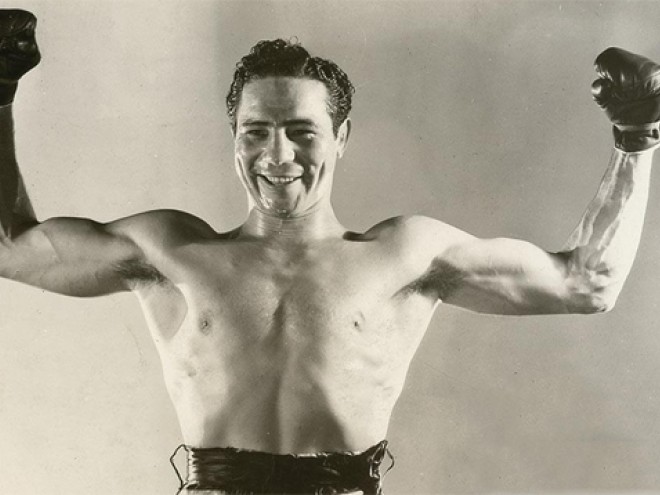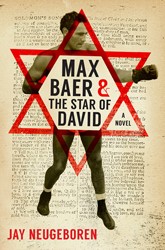Mike Silver is a boxing historian whose second book, Stars in the Ring: Jewish Champions in the Golden Age of Boxing: A Photographic History, comes out this week. Mike is guest blogging for the Jewish Book Council all week as part of the Visiting Scribe series here on The ProsenPeople.
In writing my second book, Stars in the Ring: Jewish Champions in the Golden Age of Boxing: A Photographic History, I had the opportunity to combine two of my passions: boxing and Judaism. A strange combination, you say? Well, not really.
It would surprise most people to learn that more Jewish athletes have competed as boxers (estimates are in the low thousands) than all other professional sports combined. In fact, during the first half of the twentieth century, golden age for the sport, Jewish boxers, promoters, trainers, gym owners, magazine publishers, and equipment manufacturers were all major players. In the same way they helped to create and develop the entertainment and garment industries, Jews in the boxing world — both in and outside of the ring — set standards for the sport as an art, science, and business.
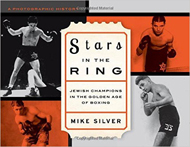 Up until the midcentury, boxing was a major spectator sport, rivaling baseball in popularity. Jewish champions such as Benny Leonard, Al Singer Jackie “Kid” Berg, and Barney Ross were elevated to hero status in poor urban communities. They were looked up to and admired by a generation of immigrants, and their children and were a source of inspiration, pride, and hope to a population struggling to break free of poverty and enter the mainstream. It is one of the most unique and colorful chapters of the Jewish immigrant experience in America.
Up until the midcentury, boxing was a major spectator sport, rivaling baseball in popularity. Jewish champions such as Benny Leonard, Al Singer Jackie “Kid” Berg, and Barney Ross were elevated to hero status in poor urban communities. They were looked up to and admired by a generation of immigrants, and their children and were a source of inspiration, pride, and hope to a population struggling to break free of poverty and enter the mainstream. It is one of the most unique and colorful chapters of the Jewish immigrant experience in America.
Between 1901 and 1939, just under thirty Jewish boxers were recognized as world champions, and over 160 were ranked among the top ten title challengers in their respective weight divisions. By 1928 Jewish boxers comprised the largest ethnic group among title contenders in the ten weight divisions. In fact, the most famous Jewish person in America during the 1920s was the peerless lightweight champion of the world, Benny Leonard. One would think this history would be widely known, at least among the Jewish people. But the reality, as I found out, is quite different.
Before, during, and after writing my book, I would go around asking people to name a Jewish boxing champion. Most often the response (especially from people under 40) was a blank stare, or sometimes even laughter. When told there were a total of 34 Jewish world champions, the reaction was usually a combination of surprise, curiosity, and confusion — as if there was something just too incongruous in putting the words Jewish and boxing together.
I found it very frustrating that this rich history appeared to be all but forgotten. It was that reaction and lack of knowledge that I hoped my book would change. I realized that the story deserved an epic retelling to fill that gap and reclaim the historical legacy these amazing athletes and personalities deserved. My goal was to accomplish this with a richly illustrated “coffee table” book that would be informative, entertaining and encyclopedic. I wanted to make this remarkable story come alive and be available to a much larger audience by rediscovering a significant aspect of Jewish history — a history that should be a source of pride for the Jewish people, and a source of information for the general public as well — especially those who have accepted Jewish stereotypes.
It was also very important to me to put the stories of the 166 boxers I profile in historical context, which is why I include introductory chapters and sidebars that explain what was happening not just in the boxing world, but amid the greater society in which the sport functioned. As the book took form I realized it was becoming not just a boxing book, but a valuable document focusing on a neglected but significant aspect of Jewish history.
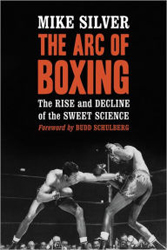 The book took about three years to complete. After finishing my first book, The Arc of Boxing: The Rise and Decline of the Sweet Science, I thought I would never write another book, because the effort was far more difficult than I had imagined. Nevertheless, I started on my second book soon after, and it turned into a labor of love. Even though I have researched and written about boxing for almost 40 years, I discovered so much that I did not know.
The book took about three years to complete. After finishing my first book, The Arc of Boxing: The Rise and Decline of the Sweet Science, I thought I would never write another book, because the effort was far more difficult than I had imagined. Nevertheless, I started on my second book soon after, and it turned into a labor of love. Even though I have researched and written about boxing for almost 40 years, I discovered so much that I did not know.
From the beginning I felt my story about the Jewish boxers of the Golden Age was very personal. I owed it to these men, who gave us so much to be proud of, to produce a quality product that would make them proud. Their praise for the book is the most gratifying part of this whole venture.
Mike Silver’s work has appeared in The New York Times, Ring magazine, Boxing Monthly, and elsewhere. He has served as an historical consultant for 19 documentaries and curator for the 2004 exhibit “Sting Like a Maccabee: The Golden Age of the American Jewish Boxer” at the National Museum of American Jewish History.
Related Content:
- Stuart Nadler: The Stories That Don’t Make It
- Jay Neugeboren: My Jewish Heroes
- Craig Darch: My Parents’ Legacy, My Library, and the Mel Rosen Biography
Mike Silver is an internationally respected boxing historian and author whose work has appeared in The New York Times, Ring magazine, Boxing Monthly and various web sites. He was historical consultant for nineteen documentaries and curator for the 2004 exhibit “Sting Like a Maccabee: The Golden Age of the American Jewish Boxer” at the National Museum of American Jewish History.
